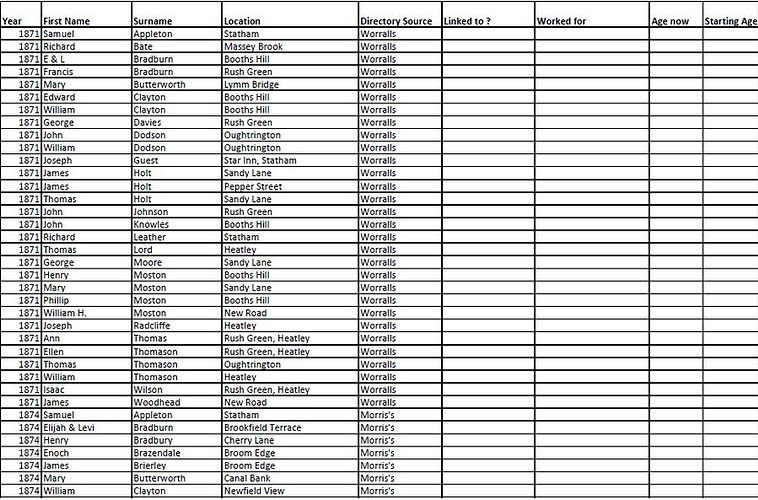Who were the fustian cutters of Lymm ?
Given that there were 720 working in the trade in Lymm on one count in 1863, and based on the fact that the trade operated for around 100 years there may well have been thousands of people employed at one time or another. Even an exhaustive search of census records would be unlikely to reveal the true scale of the work. With some people and young children working at home they may well not have listed this as their occupation.
The list we have come up, drawn from trade directories, focuses on the fustian masters or master/cutters. The master ran a workshop, typically along the top of a terrace of three storey cottages. Some may have owned their workshops. Others are likely to have rented them, possibly living on the premises too.

Thomas "Dossey" Brookes, Fustian Cutter. Thomas was also leader of the local Lymm Morris Dancers. This photograph gives a clear picture of one of the shorter frames. But look also at the working conditions, the roof falling in and newspaper stuffed in the holes. Thomas's great-grandson, Alan Taylor still lives in the village today.
A Word about the Trade Directories.
Privately published trade directories were the “Yellow Pages” of their day. As well as listing the “gentry” and “private residents” of an area there were commercial listings that purported to show all the shops and businesses of an area.
In the case of trades of like Fustian Cutting they were almost certainly incomplete. One only has to compare the numbers in different directories across the decades where the fluctuations from year to year across different directory producers go for beyond trade “ups and downs “. There was also the issue of deciding what constituted a business.
There were fustian masters with large workshops employing dozens. But at the other end of the scale there were also home workshops involving just the family and perhaps a neighbour from time to time.
Spellings were pretty flexible. We see Proffit and Prophet for the same person. We have used the spelling as given in the directory except where we have seen an alternative spelling several times.
We have stopped at 1910 where there is only reference in the Kelly’s Directory. ( There were none in the 1906 directory). But the trade is certainly still happening in those years. History Society booklets contain reminiscences well past this year.. another indication of the incompleteness of the directories.
The one additional section on our list is all the people who were interviewed by the 1863 Government Commission. They are of special interest as we can hear them describing their life and work in their own words.
The fustian masters would have varied hugely in their level of prosperity. They certainly could not be compared in any way with mill owners. They were very definitely considered tradesmen (and women) in the social class structure which was still so predominant. Some of the fustian masters combined their business with other trades like Mr Guest who ran the Star Inn in the mid 19th century. Others were also shopkeepers. Sometimes too you will find someone who started as a cutter ending up as a master in their own shop. where they may have also continued to be cutters too. Noah Prophet for example is interviewed as a 19 year old cutter in 1863 working for Mrs Holt. Twenty years later he is master of his own workshop. (He may also have inherited it from Peter Prophet) Samuel Appleton was a cutter in the 1850s but by 1863 he had his own workshop in Statham which was still going in 1902. Fustian cutters’ pay was notoriously low so it must have been a huge challenge to progress from humble cutter to having one’s own workshop though often one might have started with one’s own family as the employees. It is likely that some of the workshops started as “in the home” workshops and gradually expanded from there.
A large workshop would employ one or two “overlookers”. These were the supervisors who checked both the quality and speed of the work. That might be a member of the master’s family – See Samuel Butterworth in the 1863 report who worked for his mother Mary.
Then there were the journeyhands, skilled men and women cutters who made up the vast majority of the workforce. Youngsters were often classed as “apprentices” though this was probably as much about being able to pay them less as it was about considering them to be trainees. Occasionally a master would be brought to book by the courts for failing their apprentices as happened with Peter Prophet in 1845, though the dispute seems to be more about him failing to provide them with paid work while he lay drunk than with the quality of training.
There were other jobs to be done, sharpening the knives, treating and preparing the cloth, hauling the cloth up and down to the workshops, collecting and dropping of the finished work . In some places this may have been done by the master or overlooker but in others the work may be done by an older worker whose eyesight perhaps might have prevented them from doing the detailed cutting work ( e.g. Thomas Gatley who in 1863 was a cutter but 1891 as a 58 year old is described as a handloom labourer)
Fustian Masters of Lymm - Alphabetic Listing
Fustian Masters of Lymm - In date order - as below
Chronological List of Lymm Fustian Masters 1828-1910 drawn from Trade Directories*
*also includes interviewees of the 1863 Government Commission who were of all grades and ages











